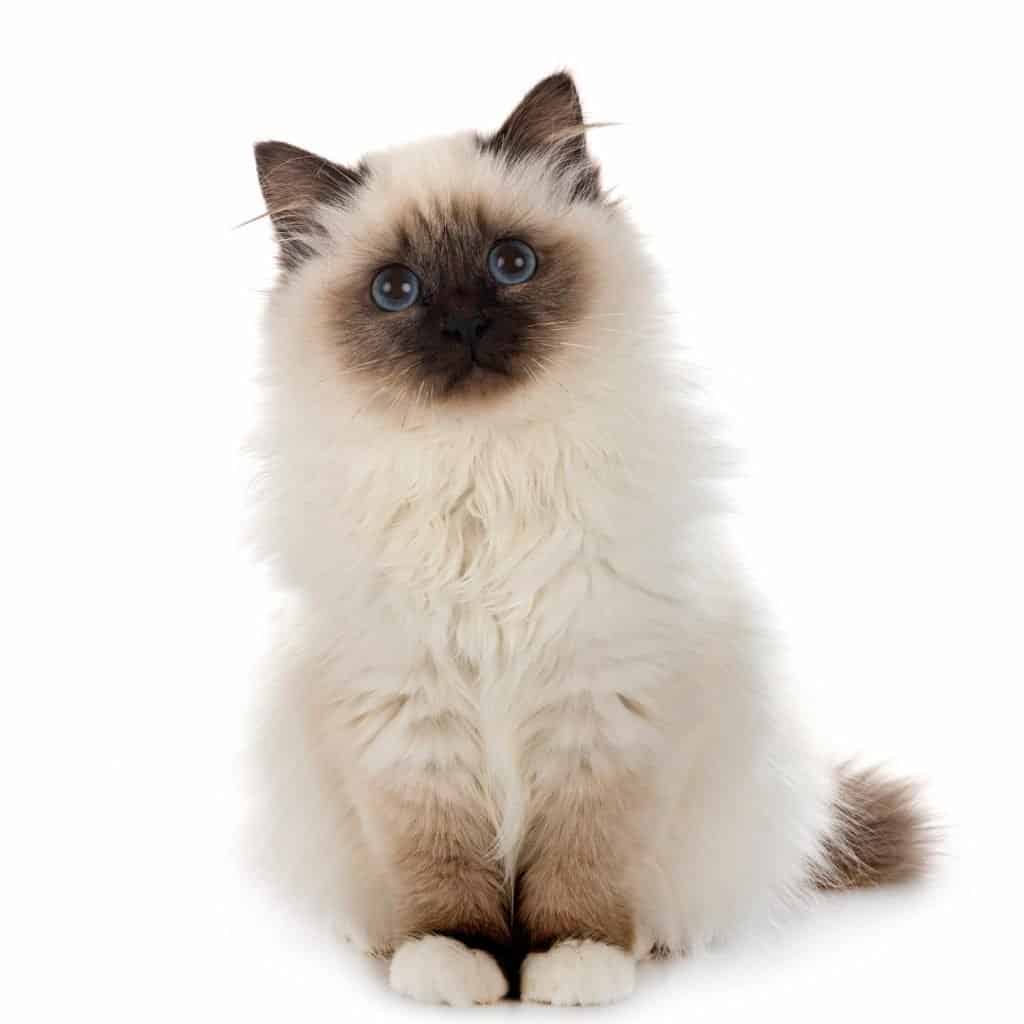The Ragdoll and Birman are two adorable cat breeds that look strikingly similar. If these two cats are next to each other in a similar color, it can be hard to tell them apart. Although they look similar, you should research the ragdoll vs. birman before deciding which cat to welcome into your home.
This article will lay out the two cat breeds and highlight their difference to better help you make your selection.
Ragdoll vs. Birman
Both the Ragdoll and Birman are affectionate and laid-back cats, but the Ragdoll appreciates being petted more. Ragdolls are substantially bigger than Birmans and tend to shed less hair. A trademark of Birmans is the symmetrical pure white “gloves” they have on each paw.
Ragdoll and Birmans are often confused with one another. They may look the same initially, but once you compare them, you will notice that they have very different attributes.
Origin of Ragdolls and Birmans
Ragdolls have a short history compared to other breeds. The Ragdoll breed was developed in America in the 1960s, by Ann Baker. Their tendency to “Ragdoll” when picked up, makes it clear where they got their name from.
Birmans on the other hand have no clear record of their origin. The oldest and most widely believed variation is that the breed originated among ancient temples in northern Burma, alongside priests.
However, many stories exist stating that the cat breed originated in Nice, France as early as the 1920s.
Size Difference
The Ragdoll is the largest of the two cats. Ragdolls, also known as friendly giants, are considered one of the largest domestic cat breeds.
They only reach their full maturity at around 4 years old. They can grow to a height of 9-11 inches. A fully grown female can weigh between 10-15 pounds, while a male can weigh a whopping 20 pounds!
The Birman tends to be a medium-sized cat. Birman cats also mature slowly; it can take up to 3 years for them to reach full maturity.

They grow to a height of 8-10 inches, weighing 6-14 pounds.
Ragdoll Personality
Ragdolls are notable for collapsing into the arms of anyone, they live for cuddles! While many cats like to keep themselves entertained, Ragdolls will follow you from one room to the next.
These kitty cats provide steadfast companionship, whether it’s sitting on the edge of your bathtub, watching Netflix, or accompanying you on a project in the house.
Ragdolls have a reputation for displaying dog-like behavior. They often learn to play fetch and come when called.
Ragdolls are one of few cat breeds that like getting their paws wet. They easily learn to walk on leashes and love going for a walk around the block.
Ragdolls are soft-tempered and easy to live with; they get along just fine with kids and other animals.
Birman Personality
Birmans tend to be quiet and a bit shy. They are prone to attach themselves to a single person, so if you are looking for a loyal companion, the Birman is perfect!
Birman cats are smart and curious. They love exploring, so it’s a good idea to keep a close eye on the little fella.
Birman’s love being involved with what you are doing. They are incredibly loving animals who like laying on your lap or sitting on your head at four in the morning.
Birmans are child-friendly and generally soft-spoken cats who love a scratch behind the ears and a good cuddle.
Ragdoll and Birman Profile Comparison
Ragdoll and Birman Coat Differences
Both breeds have similar color patterns. The brown, blue, chocolate, lilac, red, and cream are all colors allowed in both the Ragdoll and Birman breeds. So, what’s the difference?
The main difference lies in the non-colored parts- the whites.
Ragdolls have a moderately long, silky coat, and don’t have any white spots. A Ragdoll has a light-colored body, with a darker face, ears, tail and legs. The Ragdolls coat can come in four patterns.
- Mitted Ragdolls have a white fur channel that goes from their chin, through to their belly, and to their tail.
- Bicolor Ragdolls have whiter coats that mitted Ragdolls. They have white chests and bellies too, and sometimes even white back.
- Vans are the whitest.
- and color points have no white.
Birmans are considered to be more hypoallergenic. The Birman has a single layer, medium-length coat, with darker colors in the face, neck, ears, legs, and tail.
Birman cats are always color-pointed, with clearly defined masks, ears, legs, and tails. The mask should cover the whole face and should be connected to the ears by color tracing.
The remainder of the coat is a cream tint and the belly is off-white. The main characteristic is its four white paws, which look like socks or mittens.
Care and Grooming
Even though Ragdolls have long, fluffy coats, they has very little undercoat, meaning their coats do not easily mat and they shed very little.
A brushing session once a week is plenty. They do not have to be bathed often either, they usually take pretty good care of their own grooming needs. If you are gentle with your Ragdoll, they will love the attention during grooming time.
The Birman has a silky texture coat that does not mat easily. Combing it weekly will be sufficient, except for in Spring when shedding their winter coats. A warm bath helps to loosen and get rid of the shedding coat.
Health
There isn’t a big difference in the lifespan of a Ragdoll and Birman cat, both can live between 12 and 16 years.
It is important to keep a close eye on both breeds as they are prone to health problems.
Unfortunately, the Ragdoll is relatively inbred. They are not the healthiest cats, to say the least. They are prone to problems like:
- Polycystic disease: sack-like pockets that grow on the kidneys, that cause kidney failure.
- Hairballs: Ragdolls develop hairballs in their digestive system, which causes problems if they cannot get rid of the hairball properly.
- Hypertrophic Cardiomyopathy: This is a particular problem for Ragdolls. The heart muscles become abnormally thick, causing poor circulation and blood clots.
Birmans also are prone to problems like:
- Dental disease: without extra dental care, you Birman is likely to develop potential dental problems.
- Obesity: these hefty kittens are unfortunately prone to obesity.
- Hypertrophic Cardiomyopathy: A genetically inherited condition that thickens the heart muscles, and causes poor circulation and blood clots.
- Spongiform degeneration: A degenerative disease of the nervous system, causing hind-limb weakness and uncoordinated movement.
Price Difference
Ragdolls tend to be more expensive than Birmans. The price ranges for each breed is below:
Ragdoll: $1200 – $2300
Birman: $400 – $1000
Conclusion
Ultimately, choosing a Ragdoll or a Birman is entirely up to you and what you are looking for in a cat. The Ragdoll is a bigger cat and a bigger time commitment in terms of grooming.
Birmans are a little shyer and are easier to care for as they require less grooming. However, both cats are affectionate companions that look very similar. You can’t go wrong with either of these breeds!
If you still can’t make a decision check out how the Ragdoll stacks up against the Himalayan and Persian cats as well.

